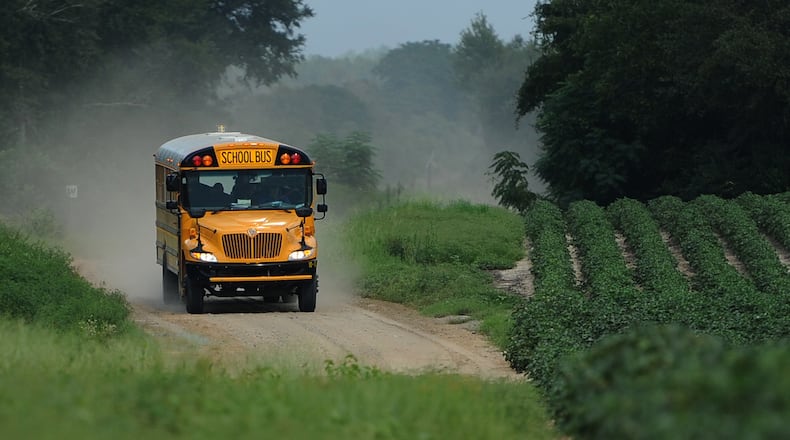A new report from a national education group says Georgia is failing to serve students well when they don’t live in a big city or the suburbs.
The report from the Rural School and Community Trust rates Georgia the seventh worst in the nation for the way it educates rural students. The problem is a big one given the state’s relatively high rural enrollment of nearly a half million students, behind only Texas and North Carolina.
"Student achievement in rural areas is low (well below the performance in non-rural areas), and the state's achievement gap for rural students in poverty ranks Georgia among the 10 highest-priority states on that measure," the authors wrote in the "Why Rural Matters, 2018-2019" report released Thursday.
It says the most “dire” measure is the low level of “college-readiness” of Georgia’s rural students. Low funding is a big reason, it says, reporting that Georgia spends $5,681 per rural student, about $700 less than the national average.
“Georgia has among the lowest levels of spending on instruction for rural students in the country,” said Alan Richard, a member of the trust’s board. He noted that Georgia’s school funding formula hasn’t been updated in decades, and said it could do better at distributing money to needy rural school districts.
While former Gov. Nathan Deal talked about overhauling the formula and empanelled a commission to recommend proposals, he didn’t undertake a change.
Gov. Brian Kemp, his successor, hasn't made an overhaul of the Quality Basic Education formula a prominent issue while in office, though he did mention it last year when he was a candidate for the office, pledging to "craft a student-based QBE Formula that expands local control."
Stephen Owens, an analyst with the Georgia Budget and Policy Institute, a left-leaning Atlanta think tank, said Kemp “mentioned a couple times on the campaign trail” that he would amend the funding formula, “but no substantive movement has happened to change it under his administration.”
Kemp has put money toward schools, giving all teachers and other educators a $3,000 raise and “fully funding” what the state is supposed to give schools based on the decades-old formula, which considers enrollment, the number of teachers, their pay level and other quantifiable factors.
Those actions benefit all schools, though, and don’t change the balance for rural schools.
Kemp’s office had no comment about the new national report, but state school Superintendent Richard Woods said through a spokeswoman it is on point: “There’s often a resource gap in rural school systems that can lead to an opportunity gap for students, which the Rural Matters report shows,” wrote the spokeswoman for the state education department, which is led by Woods. The statement noted that the Georgia Board of Education, which is appointed by governors, on Thursday approved two rural school grants worth a combined $4 million.
Funding is clearly an issue in some rural school districts. Superintendents, especially those in smaller districts with lesser economies of scale, say they feel a lack of funding most acutely when it comes to hiring, and keeping, good teachers.
Steve Smith, the superintendent in Bleckley County south of Macon, said neighboring Houston County, which has at least 10 times more students, can afford to pay starting teachers $5,000 more. “That puts us at a huge disadvantage,” he said.
He also lacks the money to hire teaching support staff, like technology or reading specialists common in larger districts. “Those are luxuries for us,” he said. He praised Kemp for sending $30,000 to every Georgia school to enhance security this year, but said he can’t use one-time grants to hire people.“There’s nothing like having another school resource officer,” he said.
Down at the Florida state line, Tim Cochran, superintendent of Decatur County, said Kemp did a “phenomenal job” by giving teachers that $3,000 boost. Like Smith, he finds it difficult to recruit and keep teachers. People who might have been teachers are choosing better pay in the private sector instead.
“We’re competing with industry that we’re nowhere near on the salary schedule,” Cochran said. He said money won’t solve everything, such as the endemic poverty that his teachers try to overcome, and he likes how Kemp supports reducing the role of testing in school report cards, whose scores he said “are directly tied to poverty.” But money sure would help with staff levels, especially with a new charter school opening in his district and peeling away 200 students. He estimates that will be $2 million in tax money out the door next year, when the latest enrollment numbers are run through the state funding formula.
“I’m not going to be able to cut enough staff to balance $2 million in a $45 million budget,” he said.
School board members and superintendents from across the state recently produced their own report on rural schools. The Georgia School Boards Association Rural Task Force report recommends more funding for teacher sick leave, noting that the state covers $18.75 per day, the same amount as in 1985. Districts are paying substitute teachers $67 to $89 a day, going out of pocket for the difference, the report said. Rural schools also need help replacing worn out buses, covering health insurance and hiring more counselors to address mental health and school safety.
Oconee County school board chairman Tom Odom led the task force in the northern half of the state and said 1,700 School Boards Association members got an opportunity to comment on the report before publication in June.
“The superintendents and boards in some rural areas have real obstacles when it comes to funding,” Odom said. Schools are paid for with a mix of local, state and federal dollars, but some small rural districts cannot assemble as much money per student as the big metropolitan districts. “Maybe rural systems need a little bit more assistance in funding ratios than urban areas,” he said.
He commended Kemp for the teacher pay raises and said the governor may have too much on his plate this first year to take on such a big challenge as school funding reform.
“I don’t think you can walk into a situation and make all the changes at one time,” Odom said.
Bronwyn Ragan-Martin, president of the Georgia School Superintendents Association, was on the south Georgia task force. She leads Early County Schools in southwest Georgia, where high poverty has produced a population of students who need extra services that she said the local tax base can’t really afford.
Kemp has traveled to her area to hear the concerns and has met with the superintendents association board, twice. He may not be able to fix everything, she said. “At least he’s listened.”
About the Author
Keep Reading
The Latest
Featured



